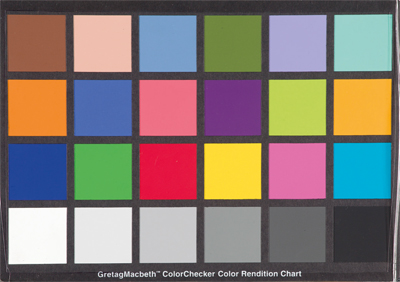articles/Lighting/lightingfordigital17-page1
Lighting for Digital part 17 - part 1 of 1 2 3 4
by Dave Montizambert Published 01/10/2010

In previous editions of this magazine, our intrepid editor, Mike McNamee, wrote some really informative articles on skintones, since then I went on a quest to find the Holy Grail of photographic flesh - The Perfect Skin-tone. In addition to this I was also determined to discover the easiest way to manipulate less-than-perfect flesh, in post. A short way into my quest, I was struck awake one night with this question, 'Is there such thing as the perfect skin-tone in photography?'
Thinking to myself that there must be, I went to the oracle of colour, the Macbeth Gretag colour checker card, and there it was at the top left corner of the original, 24 patch card, two absolutely perfect looking fleshtones (see Image 001) - a Caucasian flesh-tone called 'Light Skin Tone' and a dark flesh-tone called 'Dark Skin Tone'. I thought to myself, 'This is it, I've found it!' thinking that Macbeth would of course only use the perfect skin-tone, but then I remembered their newer Digital CC SG checker card which has many more skin-tone patches which lead to the question, 'Which one is the perfect skin-tone?'
That was it, the self doubt set in as it invariably does on any great quest, I mooned around the house for several days eating nothing but Hob Nobs and ice cream, barely sleeping.
Eventually I did rally my remaining self-worth and looked into the matter. As it turns out, contrary to what one might think, these tones are not intended as perfect skin-tones, but rather as average skin-tones. So the question remained, 'What is the perfect skin-tone and how do I get it?'
For the most part, if I white balance correctly, use Adobe's DNG Profile editor software or Macbeth Gretag's ColorChecker Passport software to weak my DSLR's profile which is created for and used by both Lightroom or Adobe Camera Raw, I generally get pretty decent skin-tones. However, often enough I look to change these tones, especially during wintertime when pale sun-starved skin could use a little fake golden glow, and so I need to edit them to push them towards the 'perfect' skin-tone.
There it is again, 'The Perfect Skin-tone.' If you ask different people what a perfect skin-tone looks like, you will get many different answers; different cultures have different ideas of what a perfect skin-tone might be. Caucasian North Americans and Europeans generally like what they call a healthy golden glow (a bit of a tan from outdoor activities such a skiing, sailing, tennis, and golf signifying a well-off creature of leisure), whereas some Asian cultures equate tanning of the skin with lower classes (outdoor labourers), and within these cultures there are subcultures like the Caucasian Goth culture where the perfect skin-tone is more corpse-like.
Within Caucasian flesh there is a fairly wide spread of 'correct' skin-tones ranging from babies and fair skinned Celts to swarthy southerners as well as outside factors that alter flesh-tone. These factors include, sun, suntan booths, windburn, and over use of various libations. Also our perception of skin-tones is affected by: a) context ie an image of a Caucasian dragging themselves through a desert won't seem right if the flesh were pale white, yet that same pale white might be the perfect skin-tone for vampire portrait. b) Chromatic Adaptation ie a photograph of a person against an intense blue backdrop will look to have yellow flesh relative to the same image shot against an intense yellow backdrop - our eyes adapt to find a mean between the range of colours in view. So it would seem that the perfect skin-tone is subjective, but I think it is safe to say that there is a range of tone that most would agree is acceptable for any given person. The real question is how do we control and measure skintones in our images to ensure they turn out the way we or our clients want to see them?
You are currently on page 1
- Lighting for Digital part 17 page 1
- Lighting for Digital part 17 page 2
- Lighting for Digital part 17 page 3
- Lighting for Digital part 17 page 4
1st Published 01/10/2010
last update 09/12/2022 14:55:47
More Lighting Articles
There are 0 days to get ready for The Society of Photographers Convention and Trade Show at The Novotel London West, Hammersmith ...
which starts on Wednesday 15th January 2025





